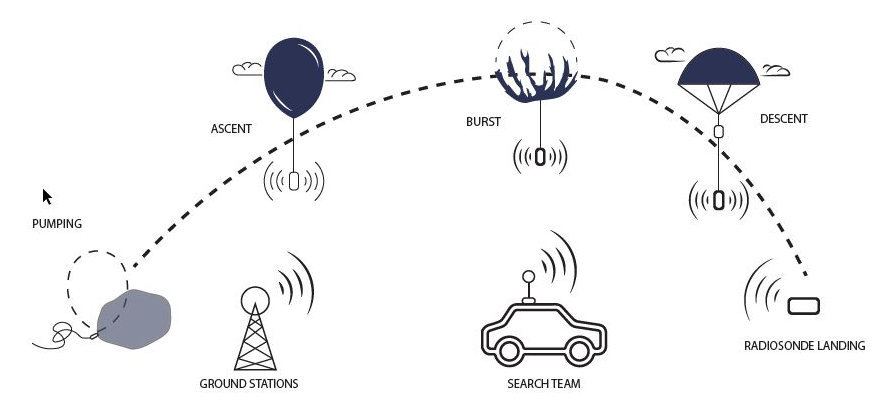Stratospheric missions of the University of Applied Sciences in Tarnow
Part 1: hardware and software
DOI:
https://doi.org/10.55225/sti.565Keywords:
stratospheric balloon, radiosonde, APRS, Horus, SSTV, radio amateurAbstract
The article describes the process of preparing and sending three balloon missions by students members of the Electronics Student Scientific Club „Amper” of the University of Applied Sciences in Tarnow. The first part describes more important issues related to the balloon flight (selection of appropriate equipment, gas used and obtaining the necessary permits). This part also describes issues related to forecasting flight routes in order to increase the chances of successfully carrying out the entire mission. The next chapter describes both the equipment designed by students and used during the mission (radiosonde, data recorder, SSTV transmitter) and factory-made commercial equipment (GNSS locator, camera). The next chapter describes the software and hardware used to monitor the balloon’s flight. The last one describes the use of the SondeHub system. This system allows enthusiasts to track the flight paths of balloons, both those sent by weather stations and amateur ones. Additionally, it has a database system storing a complete set of data sent by the radiosonde (both location and telemetry). The article is an application note and may be helpful for people who want to carry out their own stratospheric missions.
Downloads
References
Organizacja Międzynarodowego Lotnictwa Cywilnego (ICAO). Przepisy ruchu lotniczego. Załącznik 2 do Konwencji o międzynarodowym lotnictwie cywilnym [Internet]. 2016 [cited 2023, Oct. 18]. Available from: https://www.ulc.gov.pl/_download/prawo/prawo_miedzynarodowe/konwencje/Zalacznik_2_-_Przepisy_ruchu_lotniczego_-_pop._45.pdf. Google Scholar
PANSA. Informacje ogólne [przepisy Polskiej Agencji Żeglugi Powietrznej]. [Internet; cited 2023 Oct. 18]. Available from: https://www.pansa.pl/asm1/. Google Scholar
Stratosferycznie.pl. [Internet; cited 2023 Oct. 18]. Available from: https://sklep.stratosferycznie.pl/wpcontent/uploads/2021/09/balony_meteorologiczne_parametry_techniczne.pdf. Google Scholar
Polskie Towarzystwo Rakietowe – Amatorskie Konstrukcie Rakiet. Forum dyskusyjne. Kalkulator wymiarów spadochronów [Internet]. 2021 [cited 2023 Oct. 18]. Available from: https://forum.rakiety.org.pl/viewtopic.php?t=3263. Google Scholar
Sondehub. Balloon burst calculator. [Internet; cited 2023 Oct. 18]. Available from: https://sondehub.org/calc/. Google Scholar
Windy.com. [Internetowy Serwis pogodowy]. 2023 [cited 2023 Oct. 18]. Available from: https://www.windy.com/50.012/20.988?49.608,20.988,8. Google Scholar
W stratosferę: projekty klubów SPSWWL & SPSYAM. Zgłoszenie lotu w PAŻP. [Internet; cited 2023 Oct. 20]. Available from: https://wstratosfere.pl/mp_service/zgloszenie-lotu-w-pazp/. Google Scholar
Sondehub Predictor. [Internet; cited 2023 Oct. 22]. Available from: https://predict.sondehub.org/. Google Scholar
Krahn T. Pecan Pico 4. [Internet; cited 2023 Oct. 22]. Available from: https://github.com/tkrahn/pecanpico4. Google Scholar
Kroes R. HorusBinary Tracker. [Internet; cited 2023 Oct. 22]. Available from: https://github.com/RoelKroes/HorusBinary_Tracker. Google Scholar
Nousiainen M. RS41ng [Amateur radio firmware for Vaisala RS41 and Graw DFM-17 radiosondes]. [Internet; cited 2023 Oct. 22]. Available from: https://github.com/mikaelnousiainen/RS41ng. Google Scholar
STMicroelectronics. STM32 ST-LINK utility. [Internet; cited 2023 Oct. 25]. Available from: https://www.st.com/en/development-tools/stsw-link004.html. Google Scholar
Hoffman J. Zostań mistrzem Arduino: projekty dla początkujących i zaawansowanych. Gliwice: Wydawnictwo Helion; 2019. Google Scholar
Shovkoplyas A. SSTV Tools. [Internet; cited 2023 Oct. 25]. Available from: http://www.dxatlas.com/sstvtools/. Google Scholar
RTL-SDR.com. SDRSharp Users Guide. [Internet; cited 2023 Oct. 25]. Available from: https://www.rtl-sdr.com/sdrsharp-users-guide/. Google Scholar
SondeHub Amateur. [Internet; cited 2023 Oct. 25]. Available from: https://amateur.sondehub.org/. Google Scholar

Downloads
Published
How to Cite
Issue
Section
License
Copyright (c) 2024 Jakub Antosz, Regina Arabik, Jacek Jasielski, Maciej Witek, Łukasz Ciężadło

This work is licensed under a Creative Commons Attribution-ShareAlike 4.0 International License.



